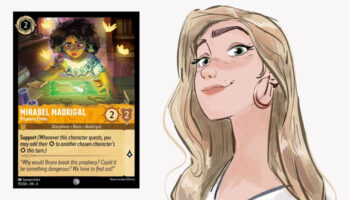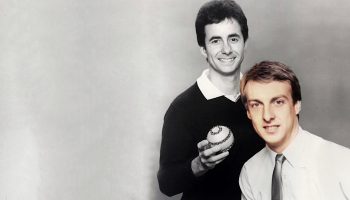What makes sizzles sizzle? Video producer Stuart Turner on making the first ten seconds count

Stuart Turner. Thanks for making time. For context, I should explain that we first met when you were 11 years old… Immature. Mischievous. No respect for authority…
I see where this is going!
…but what were you like at school?!
Ha! I was short, with a blazer and a satchel.
Perfect. Ha! So the reason we’re chatting today is because you run the media production company DMI Productions… Over the years, DMI has produced countless sizzles for media companies and – indeed – a fair few promotional videos for toys and games. Who are some of your clients?
In toys and games? Asmodee, Bananagrams, The Creativity Hub…
I actually meant in general!
Oh! Then The Walt Disney Company, Sony Pictures, NBC Universal, BAFTA, ChildLine… How many do you want?
That’ll do. I’m only being polite!
Charming.
Well, in all seriousness, I don’t want people thinking this is a plug for DMI because you’re quite a high-end production company. Readers shouldn’t be coming to you to make pitch sizzles! They could be doing it on their own… But I thought you’d be a great person to help walk through the process of writing one. Which means the very first question is: what – to you – is a sizzle?
The short answer is that – in video production – the word sizzle is a pretty specific thing. It’s a short, promotional video that shows the most interesting, representative or exciting parts of something. It might sell a TV show, for example, or a physical product.

But there’s a longer answer?
Only because the word has broadened in meaning! Nowadays, some people use it as if it’s interchangeable with the word video. Which isn’t helpful! For example, we’ve had people ask advice about making a sizzle video when what they meant was a ten-minute video that walked through their game rules.
A how-to-play video?
Exactly. Nothing to do with a sizzle! And – as you know – if the inventor relations folks ask for a sizzle and you give them a 10-minute how-to-play video… We’ll, there’s a very real chance that won’t get watched.
Right. And when you say a sizzle is short, then, what does that mean? In seconds or minutes?
That used to be easier to answer than it is now! Even a few years ago you could be fairly sure that, if someone referred to a sizzle, they meant a video about one minute long… And certainly not more than two minutes.
It sounds like that’s changed?
Yes, because two things have happened. First, as I say, the word sizzle has started being used by people that don’t quite understand what it originally meant. Second, people’s need for speed is greater than ever – so the things that really ARE sizzles are often much shorter these days. You know, I think you sum the problem up quite well when you say, “Every sizzle is a video, but not every video is a sizzle.”

Yes! Good quote! What do you think I mean by that?!
You’re emphatic that the word ‘sizzle’ comes from marketing speak… From a lovely phrase that helps people remember to focus on selling benefits, not describing features: “Sell the sizzle, not the sausage.” Its about emotion, not just facts. So to answer the original question… If a toy professional asks you for a sizzle video, they probably mean a piece – between 20 and 120 seconds – that’s fast paced and stimulates an emotional response.
Agreed. And I wouldn’t say any of this is set in stone, but pitching a toy tends to be a quicker affair than pitching a game. So I know Hasbro’s rule of thumb, for example, fits in with the way we see it: one minute for a toy; two minutes for a game. Four minutes for a heavier tabletop title.
Is that right? Well, yes – that’s good! Just quickly… There’s something else I wanted to say about the way the toy industry uses the word sizzle… It’s a world away from a sizzle in a lot of video production companies. A sizzle for a toy or game pitch can be really rough round the edges – it rarely needs to look slick. In other industries, though, a sizzle is the definition of slick! It’s also very common for an inventor’s pitch sizzle to have a voiceover; one that describes what’s happening in a compelling way.
Right. Which we’re going to spend quite a bit of time talking about here…
Yes – but outside toys and games, that’s quite unusual. I’d say about 95% of the sizzles we make at DMI feature music only – or music with a few sync lines from a TV show. There’s rarely any scripted voiceover. That’s very different from what the toy industry calls a sizzle.
So I guess the takeaway point is to make sure you understand what toy companies want, and to be very careful about using the word sizzle elsewhere… In toys and games, though, they probably do mean a 20- to 120-second video. They probably DO mean one that moves along quite quickly… But they almost certainly DON’T need it to be beautifully slick, or scriptless!
Exactly. You can also think of it as an internal advert for the invention, so it can be pretty cheap and cheerful. I mean… Some of the bigger invention studios do put quite a bit of money into these things, but new inventors don’t really need to. Is that fair to say?
I think so, yes!
And going back to what I said about the need for speed, even 120 seconds has started to feel quite long. People are busy, and their attention spans are very short. Worryingly so! So when I hear the words pitch sizzle, I personally think in terms of 20-60 seconds. That said, it’s also about having the right music, editing and script. Get it right and a 90-second video can absolutely fly by. Get it wrong and a 30-second script can feel like an eternity.
Let’s talk about that, then! Presuming an inventor’s most likely going to film something on a camera phone, or use still photos and a voiceover… Where do they start?
Good question. You surprise me!
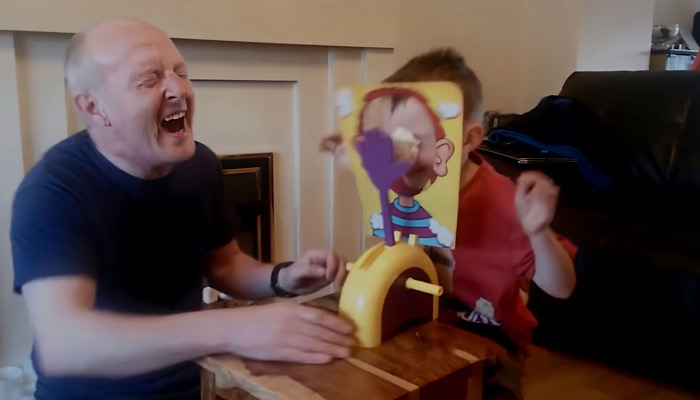
Ha!
The first thing they need to do is work out what it is about their idea that’s most compelling. Everything more or less hangs off the idea’s big moment! That might be the way a game is won or lost, or it might be the most exciting thing that a toy does.
And let’s make this a little less abstract! Can you give us an example?
Sure! Do you remember the TV advert for Hasbro’s Pie Face? That’s a perfect example… They didn’t start out by showing you how to set the game up, or give any context to what was happening. They very quickly get to the pie in the face. As I recall, the ad starts and we see an old man laughing a little, a kid getting a pie in the face… And then the old man laughing a LOT! That’s all within the first five to ten seconds.
Great example! As our late friend Eric Gates used to say: “Crash, bang, wallop! You’re all there!”
Exactly right. Buckaroo would be the same. I haven’t seen an ad for that recently but – if there’s a modern ad – I’ll bet you see the donkey buck within ten seconds of the start.
And just to be clear, why are we suddenly talking about adverts for toys here? Aren’t they different from sizzles?
Good point! You’re absolutely right. To clarify: some TV adverts for toys use the same structure as inventor sizzles. Why? Because they get to the action very quickly – and that’s often what you want in a TV advert. So the examples I’ve just given ARE TV ads… But I’m talking about the structure of those adverts so that inventors can understand the structure of a sizzle.
Got it. And in that respect, have you got a good example of a toy advert that has a sizzle structure?
I don’t know why this comes to mind, but John Adams had something called Magicolor. The TV ad for that was filmed more or less like a sizzle. I don’t remember the exact timings, but you saw maybe five seconds of a kid colouring in some artwork. Then – certainly within ten seconds – you saw the drawing come alive!
It animated?
No, it was real magic, Deej; it actually came alive!
Rude.
Ha! Yes… It animated. You colour in the pictures… Lower a screen. Pull a lever. The drawing animates! And the same thing applies there. John Adams didn’t spend any airtime showing a person putting the drawing in the frame or lining up the paper. They didn’t show anyone putting the lens in place… As you say, “Crash, bang, wallop! You’re all there!”
Okay. I don’t know that product but it sounds like a good example. And I’m glad you mentioned John Adams, actually… Their TV ads do tend to be structured like a sizzle.
Yes – and sometimes they’re only on for 15, 20 seconds. But they usually show you the big moment very early on, then maybe a bit more about what you’re getting… That said, the Windy Knickers ad misses the mark. I think that’s theirs! Is that John Adams? Either way, they do tend to nail it.
It’s Ideal, so… I don’t know who made the ad. But let’s say people are persuaded by this, Stuart… What would they need to show after “the big moment”?
Well, it depends on the product. After showing that key moment, however, it’s then common to give it some sort of context. That’s why – before you film anything – it’s a question of working out the most efficient way to explain the idea. One way of doing it is to get a stack of blank postcards…
These are blank record cards… From the stationers?
Exactly. Or wide Post-It Notes – they’re great! I mean, you could just use scraps of paper if you’re desperate, but – later – it’ll be better if you’re using a neat oblong shape. In any case, you then write – in the top left corner of each – a keyword… Something you absolutely have to mention and show in the sizzle.
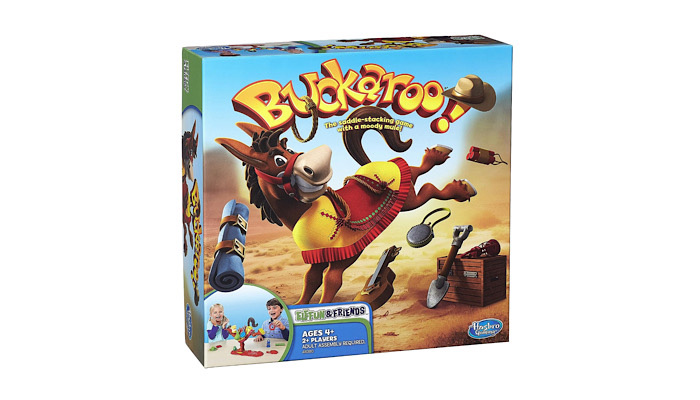
Can you give us an example?
Let’s use Buckaroo as an example. This is much more your area than mine, but what words would you have to include if you were trying to communicate that idea? To someone who’d never seen the game before?
To someone who’d never seen it before? The name of the game, obviously… Mule. Buck… Load up – or stack… Saddle. Maybe I’d say kick! Supplies, maybe; maybe I’d say accessories or kit. If I’d come up with a strapline for the game, I’d write that down. Actually, let me look that up…
You’d also say the number of players, wouldn’t you? Which I guess is four. And the minimum age…
Yes, I probably would for Buckaroo. The strapline, by the way, is: ‘The saddle-stacking game with a moody mule!’ Which I like. And it’s age four plus. Let me write all this down… One thing per card!
Okay… Obviously, this is part video production, part scriptwriting – and you’ve done this a thousand times before, so I’ll ask you! Once you’ve got words on cards like that, what do you do?
First, I put a circle around the word that represents the big moment. So in this case it would be ‘Buck’. Then I look at the other cards. The idea is to shuffle them round until it feels like we’re using as few words as possible before we get to the mule bucking. What’s the fastest way you could get there using some of these keywords? What order would the cards go in?
Using just these words?
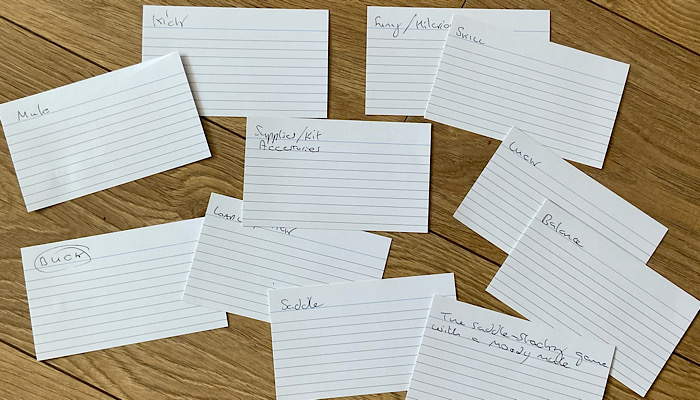
No, you can link them together – but there’s no point writing down things like ‘and’ or ‘don’t’ until we’re sure that’s what we want to say. And you know, in terms of keywords, we could also throw in ‘funny’… ‘Skill’. ‘Luck’… You know? Words to describe the tone of the game.
Got it… ‘Balance’. ‘Hilarious’.
Right.
Well, then it’s got to be something like… Hang on…
And you see what you intuitively did there? You just very naturally started shuffling those word cards into a different order on the table. That’s why this is such a smart technique: you’re writing without doing much writing!
Yes. And it’s pretty quick too, because while you were blathering on there, I put the first few cards in the order: Stack, saddle, mule, buck… And in my head I’m thinking it’s got to be something like: “Stack the saddle, but don’t let the mule buck!” Something like that?
Right! “Stack the saddle, but don’t let the mule buck!”. I’d be happy with that! So now, we can write the linking words on the cards.
“Stack the”, “saddle – but don’t let the”, “mule”, “buck”…
And that means you reached the word ‘buck’ – the big idea – in nine words! In a voiceover, that’s going to be well under five seconds. You’ve also – helpfully – given a little bit of context to the gameplay, which is perfect… Because you don’t want them blinking and missing the big idea. So what you said there was great.
I knew writing was easier than you made it look!

Oh, no question! Actually, the most difficult part of my job is making it look hard! Anyway, once you’ve done that first sentence, you also jot it down on a separate piece of paper. For now, those particular cards have kind of done their job. We wrote on them very roughly, which is fine because we might change things, but we’re going to do the same thing again with the keywords that are left over.
Buckaroo, Balance, Funny, Skill, Luck, Kick… Age 4+, two to four players. Supplies, accessories or kit. The saddle-stacking game with a moody mule!
We can shuffle those cards around to go beyond the big idea… So picking it up, maybe I’d say, “Buckaroo is for two to four players, age 4+… Who can balance the most kit on the donkey’s back?”
Funny and skill? Can they go in there?
Absolutely! And ‘luck’: “Buckaroo is a funny game of skill and luck for two to four players, age 4+… Who can balance the most kit on the donkey’s back before he kicks?” Then, for the outro, let’s pretend we came up with that strapline…
I’m writing all this down like we’re really going to pitch it! We’re the inventors of Buckaroo!
You say that! Did I ever tell you about the time Billy went to dinner with a load of toy inventors he didn’t know? One of them turned to him and said, “So what is it you do?“ Well, that day, Billy had been running an inventor session for Rubik’s – finding new ideas for them. And he was so tired – drunk with fatigue, as I like to say – that he very absently said, “I’m Billy, um, Langsworthy… I’m… I’m – er – the inventor of the Rubik Cube.”
Ha! No?!
My hand to God! He got a bit of stick for that. I’m honestly amazed Adam Butler lets him out on his own. Anyway! We’re about to use the leftover cards for the last sentence. Maybe we just need to sum it up: “Buckaroo! The saddle-stacking game with a moody mule.” Now, when you put all that together, you’ve got a sizzle script.
It’s done?

It’s done! I mean, I might look at it and say ‘burro’ is a funnier word here than donkey… And I might tweak things so that I get more out of the fact that ‘luck’ rhymes with ‘buck’. I might also add that it’s a ten- or 15-minute game, or whatever… But for the most part, for illustration purposes, we’re done. I do have to stress that it’s not always this easy! But if you read it out; I’ll time it. Hang on a second. Okay… Go!
“Stack the saddle, but don’t let the mule buck! Buckaroo is a funny game of skill and luck for two to four players, age 4+… Who can balance the most kit on the donkey’s back before he kicks? Buckaroo: the saddle-stacking game with a moody mule.”
Look at that… One-Take Turner! That’s under 15 seconds. So congratulations! We have a sizzle script! Now it’s back to you. What do we do with that?
Well, now, the oblong shape of those cards comes into its own… Because, for every card, we have to work out what’s going to be seen on screen as the voiceover says those words. And you don’t have to be van Gogh to do this, but it helps to do a little drawing – just a doodle – of what you’d expect to see.
So we’re sort of doing poor man’s storyboards?
Right. Poor man’s storyboards is a very good way to describe it! Sexist, but good! And you know, you don’t even have to do drawings if you don’t want to. You can describe what we’re going to be seeing on screen. And if one shot covers more than one card, we can just draw an arrow on it.
Got it. So once you’ve got those bits of card – or Post-It Notes or whatever – in order, and then jotted the spine of the script on the cards, that’s when you start thinking in terms of pictures?
100 percent. You start asking yourself, “What are people seeing on the screen while these words are being spoken?” And to some extent – particularly with this example – the answer is obvious! If we’re going to see Buckaroo buck within – what did we say? Three seconds?
Right.
If we’re going to see Buckaroo buck within three seconds, then we’ve got three seconds to show a hand coming in and putting an object on the saddle! So on that first card you can draw roughly the shape of Buckaroo… With the bits of kit around him. Then on the next one, the same thing – but with a hand coming in with an object! Arrow here… And on here, we draw Buckaroo bucking!

So it’s matching the script to timings of playing the game.
And my suggestion here would be that we’d go in quite close with the camera, because we want to see Buckaroo buck. We might even film that in slow motion. That’s what’s missing from Windy Knickers, by the way! We never really see granny’s clothes flying off.
Ha! Not a sentence I hear often. Mercifully! That’s right though, is it? No decent close up of granny being unclad?
I think so; I think we only see granny from a distance when the line’s spinning, and only close up when not much is happening.
Would there be a reason for that, do you think? A technical reason?
I haven’t really thought about it. Maybe they didn’t have the budget to use a small camera to get in close enough to the action. Maybe they didn’t realise how hard it is to make out what’s happening at that distance? In any case, when we get to the word Buckaroo here – after it bucks and we see everything go up in the air – we can cut wider; we can show the product more in context of who’s playing…
Got it…
Then, for the next few cards – “A funny game of skill and luck for two to four players, age 4+…” What do we need to see? I think we just need to show people playing. So that might as well be one shot! And as a sidenote: don’t get distracted here! The video needs to show things working. It’s proving the concept. I know it might sound obvious, but it isn’t really ABOUT the people – or the inventor! Anyway… Arrow here, arrow here, arrow here!
Let me just clarify, then: “Buckaroo! A funny game of skill and luck for two to four players, age 4+…” For that, we’re just showing people playing it? In a wider shot?
Yes. I think that would work. And you need to show that people are enjoying it! Right? Don’t use people that look like they’ve been drinking chloroform just because they’re available! And remember: this doesn’t have to look like Spielberg shot it… It’s a quick little pitching video. So it could just be you and your kids playing it, or friends in your case. You still have friends, do you?
One fewer than I thought is the answer! No show without Punch, is there? So what’s next? Because we must be about halfway through this planning stage, right?
Yes, but the principles are the same for the rest of the process! You just keep thinking, “What do people need to see? What’s on the screen?” Answer those questions and write them or doodle them on the cards.
Are we then ready to film it?
More or less. And happily, the bar is set pretty low as regards what’s considered an acceptable standard for a pitch sizzle! Remember: you really are just communicating the idea. You don’t need to compose your own soundtrack, or create a load of graphics! It can be very crude, very simple.

Like yourself. And in terms of filming, then, I’m hearing nothing flash, nothing too fancy. Set your phone up on a little tripod and shoot the things you realise you need from filling out those cards?
Exactly. And there’s pretty obvious advice about that… For a sizzle, I’d still say make sure you shoot landscape – that’s why I suggested using oblong cards, by the way. Also, make sure it’s well lit and that you can hear people speaking and laughing… But most of that really goes without saying because modern phones let you do a pretty good amateur job if you see I mean… They won’t give you TV-broadcast quality, obviously, but more than good enough for a pitch sizzle.
Alright. And I’ll take photos of all these cards, and put them in the piece as images. That way people can see exactly what we’re talking about. Then, in terms of editing software, what should people do there? There’s apps on most people’s phones?
Yes. iMovies or similar will do it; doesn’t have to be anything flash. And if you’re working with still images, then you can do a pretty good job in Photoshop or any similar photo-editing app. Then upload them to iMovies… If you think it helps, add a bit of mood-appropriate music – but not too loud! You need to be able to hear voiceover…
It occurs to me – a bit late to be asking, really – would you ALWAYS suggest recording a voiceover?
For an inventor’s pitch video, I can’t think when I wouldn’t… As I say, it’s very rare for a sizzle to have a voiceover in some industries. But for inventor pitches, it’s easily the most efficient way to put over the idea. I also recommend getting someone with a half-decent voice to read the script. But look, a lot of the software is so intuitive… I honestly believe that people that want to know how to do this stuff can learn more by trying to do it a few times than they ever will by reading about it.
Well, why didn’t you say that at the start? We could’ve knocked this on the head and gone for KFC.
Still can. Mmmmmmm. Zinger Burger!
Sold! Stuart Turner, thank you very much. Let’s go!

–
To stay in the loop with the latest news, interviews and features from the world of toy and game design, sign up to our weekly newsletter here










